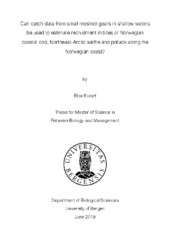| dc.description.abstract | Shallow waters (<30 meters) are important nursery areas for coastal cod, saithe and pollack, before they recruit to their respective fisheries at an age around 3 years old. Still, no study provides information on fish abundance in these nearshore habitats. This study has analysed a time series of catch data from fyke- and trammel nets in the sublittoral between 62ºN-68ºN from 2013-2018. The aims were to evaluate the gear’s ability to catch recruits (0-2 years old) and to examine if these data could be used to establish recruitment indices for Norwegian coastal cod (Gadus morhua L.), Northeast Arctic saithe (Pollachius virens L.) and pollack (Pollachius pollachius L.). Results showed that 68% of the cod catch was under 3 years old, most of them caught by fyke net. The fyke nets were also able to catch recruits of saithe (68%) and pollack (35%), but these catches were irregular, with a small number of stations contributing to most of the catch. A generalized linear mixed effect model was used to estimate recruitment indices for cod, while this modelling approach failed to provide indices for saithe and pollack, due to the patchy distribution in the data sets. Overall, the indices of cod showed a higher level of recruitment further north, and there was a great annual variation, particularly for the 0-group. To evaluate the indices, mean CPUE of the shallow-water survey were compared to the index of the same year classes as 3-year-olds in IMR’s acoustic coastal survey, operating in the same areas at deeper waters. There was a positive relationship between the mean CPUE of 2-year-old cod and the acoustic index of 3-year-old cod in the northern subarea (65ºN-68ºN). In the southern subarea (62ºN-65ºN), there was not a sufficient number of year classes to provide a comparison of the two surveys. Comparison of the year class abundance of saithe between the two surveys suggests that fyke nets might be an appropriate gear for catching saithe recruits, regardless of the irregular catches. There was a positive relationship between the mean CPUE of 2-year-old saithe and the acoustic index of 3-year old saithe in the northern subarea. In that case, it is recommended to assume a negative binomial distribution or using zero-inflated models. There were no time series of pollack in the study area that could be used for comparison recruitment abundance in this thesis. The time series from the shallow-water survey is still quite short, as there are three years of survey in the northern subarea (2013, 2016 and 2018) and two years in the southern subarea (2015 and 2017). Hence, the present study gives a preliminary assessment of the survey. It is recommended that the survey is continued with cod and saithe as target species, preferably with both subareas each year. As the trammel nets failed to provide sufficient catches of recruits, these could be excluded from the survey to save time and resources. | en_US |
